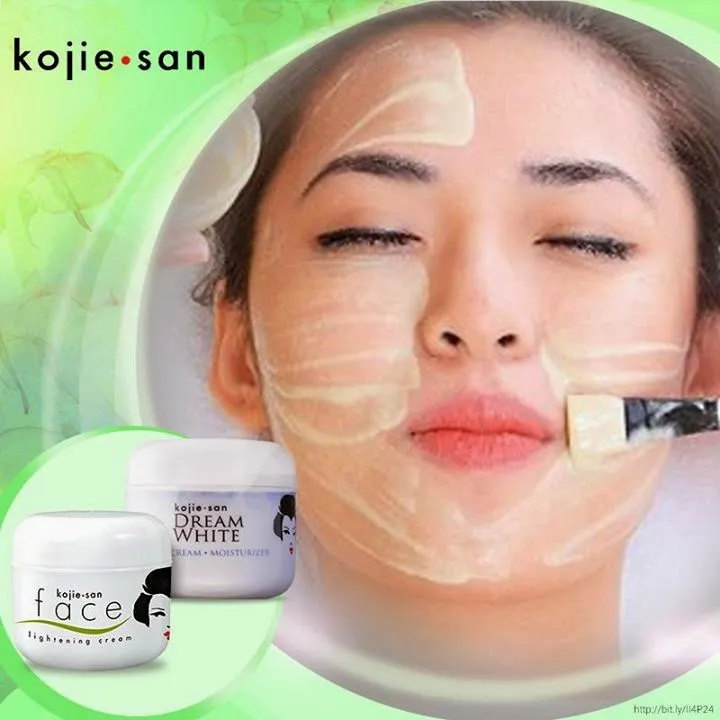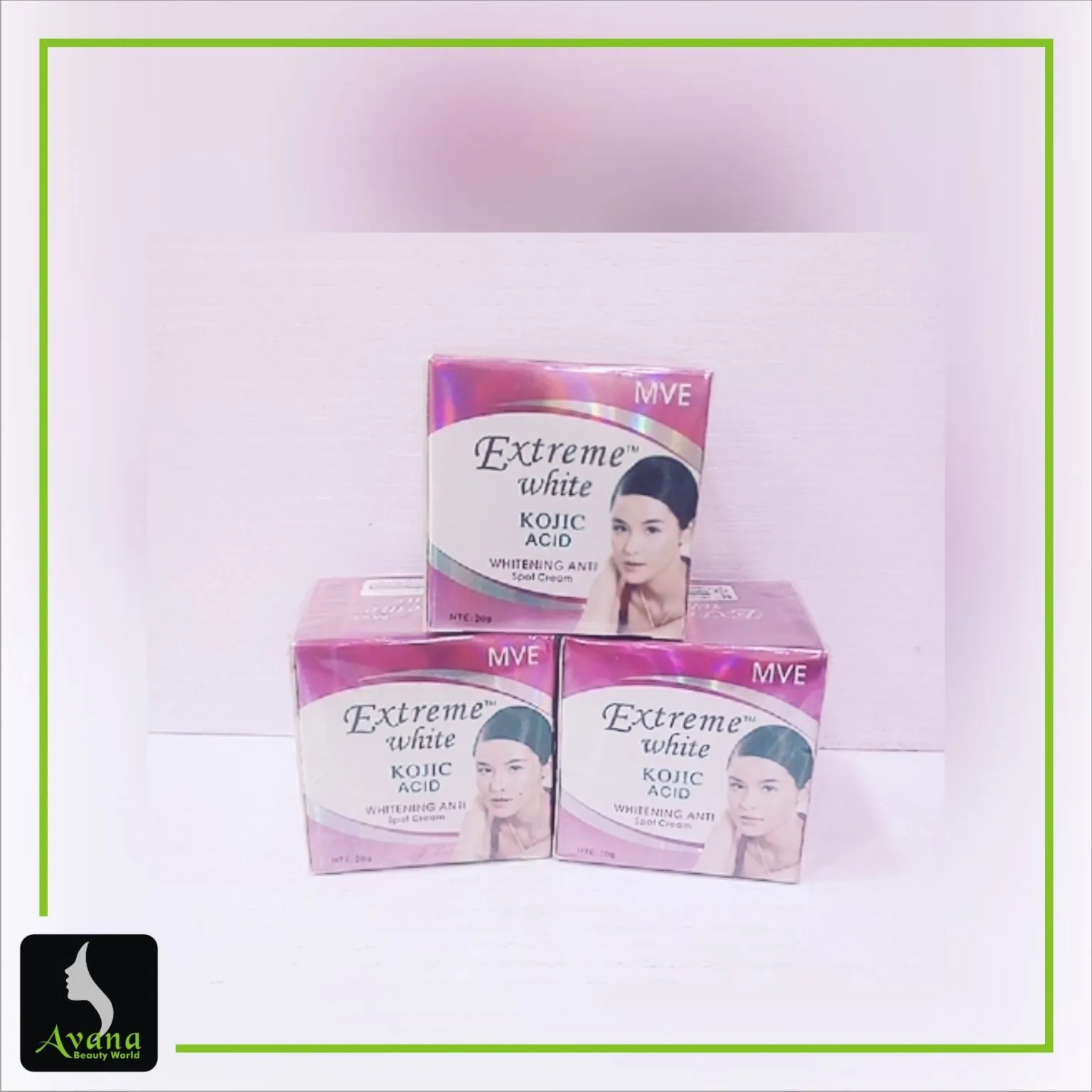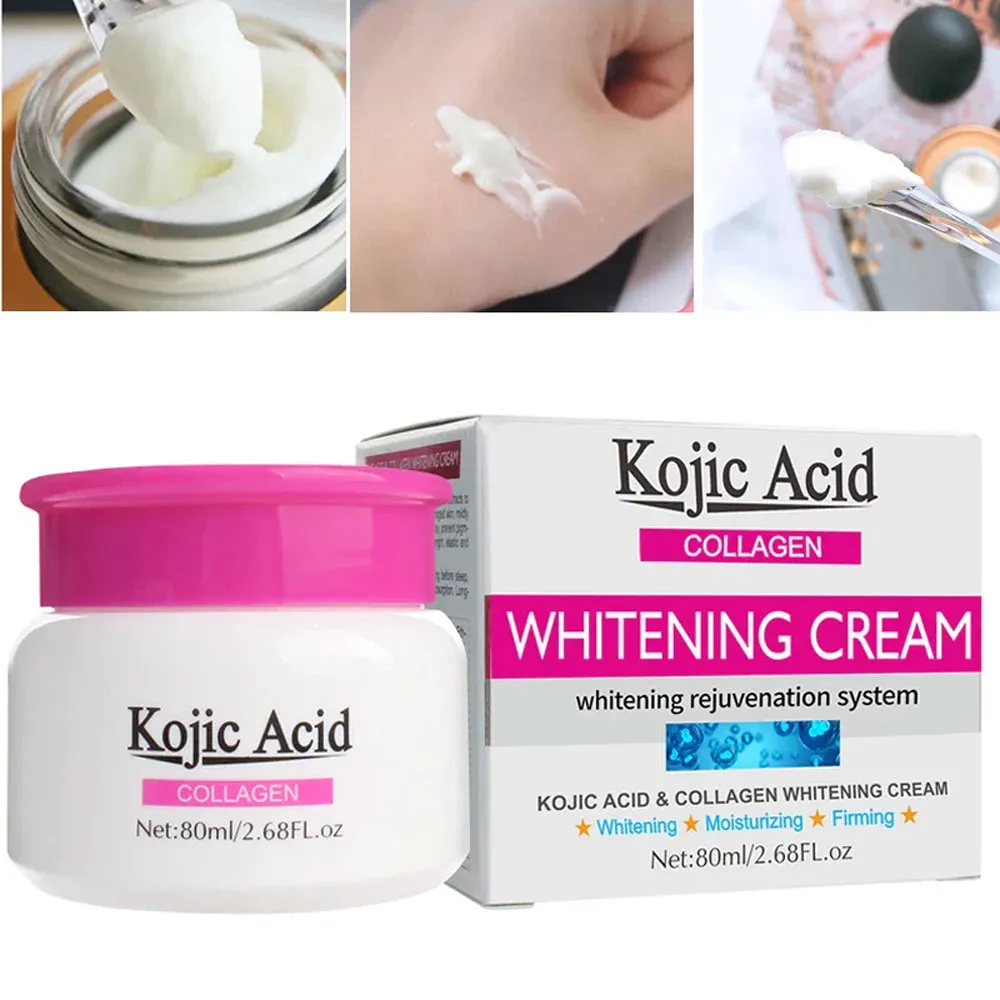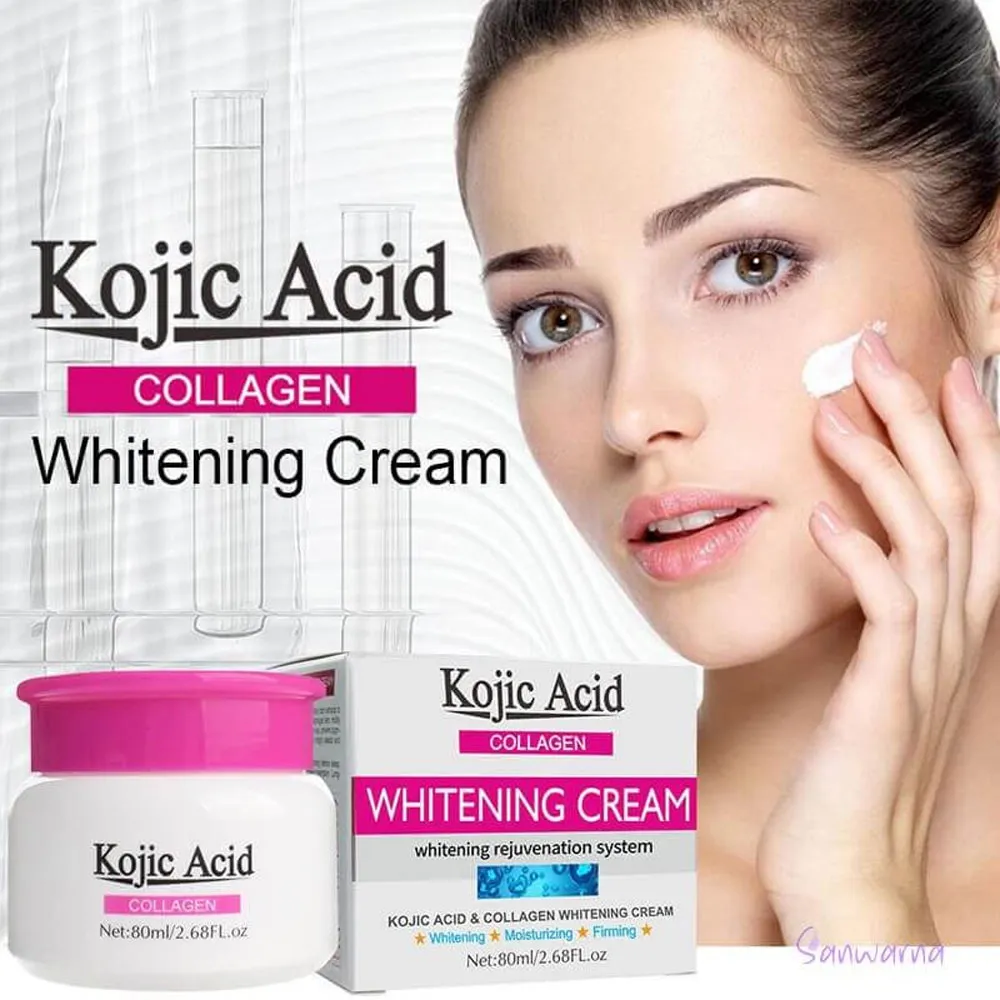What is Kojic Acid?
Kojic acid is a naturally occurring compound produced by several species of fungi, particularly those used in the fermentation of foods like soy sauce and rice wine. It is celebrated in the skincare industry primarily for its skin-lightening properties. The acid works by inhibiting the production of melanin, the pigment responsible for skin color. By interfering with melanin production, kojic acid can help to reduce the appearance of dark spots, sunspots, and other forms of hyperpigmentation. Its antioxidant qualities also contribute to skin health, protecting against environmental damage. This versatile ingredient is a popular choice in many skincare products due to its effectiveness and relatively gentle nature compared to some other skin-lightening agents. It is also commonly used in creams, serums, and soaps, often combined with other beneficial ingredients to enhance its effects and provide additional skincare benefits.
Benefits of Kojic Acid for Skin Whitening
Kojic acid offers several benefits for skin whitening, making it a sought-after ingredient in skincare routines. Its primary function is to lighten skin by reducing melanin production. This can lead to a visible reduction in dark spots, freckles, and uneven skin tone. It is particularly effective in addressing hyperpigmentation caused by sun damage, acne scars, or melasma. Besides its whitening properties, kojic acid also possesses antioxidant qualities, helping to protect the skin from free radicals and environmental stressors that can accelerate aging. Furthermore, it can help improve skin texture and give the complexion a more radiant appearance. The use of kojic acid can contribute to a more even, brighter, and youthful complexion, making it a valuable addition to any skincare regimen focused on achieving a glowing and healthy skin appearance. Many users have reported noticeable improvements in skin tone and clarity after consistent use.
How to Make Kojic Acid Whitening Cream

Creating kojic acid whitening cream at home can be a rewarding experience, offering control over ingredients and the potential for cost savings. However, it requires careful attention to detail and hygiene to ensure effectiveness and safety. The process involves several key steps, starting with gathering the right ingredients. It is essential to use high-quality ingredients and follow a precise recipe to achieve the desired results. The formulation typically involves a water phase, an oil phase, and an emulsification process to combine the ingredients smoothly. Proper mixing techniques and the use of a suitable emulsifier are vital for the cream’s consistency. The addition of kojic acid and other beneficial ingredients at the appropriate stages is crucial for the final product’s efficacy. Finally, proper cooling and packaging of the cream are necessary to maintain its stability and extend its shelf life. Each stage requires following the instructions carefully to prevent any issues.
Gathering Your Ingredients
The success of homemade kojic acid whitening cream hinges on gathering the right ingredients. First, you’ll need distilled water for the water phase and a selection of oils like sweet almond, jojoba, or grapeseed oil for the oil phase. These oils provide moisture and act as a base for the cream. You’ll also need an emulsifying agent such as emulsifying wax to bind the water and oil phases together. Kojic acid powder is the star ingredient, so ensure you source a high-quality, pure form. Other optional ingredients can include glycerin for added hydration, vitamin E oil for antioxidant benefits, and a preservative like phenoxyethanol to prevent bacterial growth. Weighing all ingredients accurately with a kitchen scale is crucial for the recipe’s effectiveness. It is advisable to sterilize all equipment such as mixing bowls, spatulas, and containers before use to avoid contamination. Having all the necessary ingredients ready and organized before starting the cream-making process streamlines the process and minimizes the chance of errors.
Step-by-Step Cream Preparation Guide
This step-by-step guide outlines the process of making kojic acid whitening cream, ensuring you achieve a product that is effective and safe. Following each stage carefully ensures the final result is both stable and beneficial for the skin. From preparing the water and oil phases to adding kojic acid and packaging the final product, each step is designed to help you make a successful cream. Ensure you are working in a clean and sterile environment and use the right equipment. Paying close attention to temperature, mixing times, and ingredient measurements is very important for achieving the desired texture and consistency. Throughout the process, it is very important to maintain proper hygiene and adhere to the procedures outlined to avoid any contamination issues and guarantee the final product’s safety and shelf life. The process may look difficult, but once you do it it will be easier next time.
Step 1 Preparation of the Water Phase

To prepare the water phase, heat distilled water in a heat-safe container. Add any water-soluble ingredients, such as glycerin, to the water and mix well until dissolved. The temperature should be between 160-170°F (71-77°C). It is very important to use distilled water to avoid introducing impurities that could affect the cream’s stability. Use a thermometer to ensure the water reaches the correct temperature, and maintain this temperature for the time specified in your recipe. Ensure all ingredients are completely dissolved. Once ready, set this mixture aside, keeping it warm for the next steps. Careful preparation of the water phase is the first step of creating a quality cream base. The temperature is very important. Avoid overheating or contamination of the mixture at this stage, as it will impact the cream’s final texture and effectiveness.
Step 2 Preparation of the Oil Phase
In a separate heat-safe container, combine the oil phase ingredients, including your selected carrier oils and emulsifying wax. Heat the oil phase in a double boiler or using a heat-resistant bowl set over a pot of simmering water, allowing it to reach the same temperature range as the water phase. Keep a close eye on the mixture to ensure the emulsifying wax melts completely. The key is to allow all ingredients to mix properly. Gentle stirring is advised to promote even heating. It is also very important to maintain a consistent temperature. Avoid overheating the oils, as it can degrade their properties and affect the cream’s final consistency. Preparing the oil phase correctly is very important. The proper preparation of the oil phase plays a key role in creating a stable and effective cream.
Step 3 Emulsification Process
Once both the water and oil phases have reached the target temperature range, carefully pour the water phase into the oil phase. Use a stick blender or immersion blender at low to medium speed to mix the two phases. Blend the mixture continuously until it starts to emulsify and thickens, changing from a watery consistency to a creamy texture. This process usually takes several minutes. Continue stirring until the mixture is thoroughly emulsified, and the ingredients are evenly distributed. During this process, maintain a consistent speed to avoid separation. Once emulsification occurs, the cream begins to take on its characteristic appearance. At this stage, the cream should look smooth and consistent. After the cream is formed, allow it to cool to room temperature while stirring occasionally to prevent the ingredients from separating.
Step 4 Adding Kojic Acid and other Ingredients

Once the cream has cooled down to a temperature of around 100°F (38°C), it is time to add the kojic acid. Add the kojic acid powder and other heat-sensitive ingredients, such as vitamin E oil, and preservatives. Stir gently and thoroughly to ensure that all ingredients are well incorporated. It is important to add kojic acid at this stage. Mixing the ingredients too early can degrade the effectiveness of the kojic acid. Be sure to take your time when mixing the ingredients to ensure an even distribution throughout the cream. Ensure the addition is done gently and slowly to avoid disrupting the cream’s emulsion. The final mix will show the cream’s complete appearance, and the combination of all ingredients will boost its skin-lightening effects.
Step 5 Cooling and Packaging the Cream
After adding the kojic acid and other ingredients, it is important to transfer the cream to a clean container. Once you have your container ready, fill it with the cream and avoid any air pockets. Allow the cream to cool completely at room temperature before sealing the container to avoid condensation. Proper packaging will extend the cream’s shelf life and keep it from contamination. Label the container with the date of creation, and all the ingredients. Proper labeling ensures you know the cream’s details, as well as any possible allergens. Storing the cream in a cool, dark place, away from direct sunlight and heat, is very important for maintaining its quality and potency. Following all these steps will guarantee the shelf life of the cream. A well-packaged and correctly stored cream ensures its safety and efficacy over time.
Tips for Effective Whitening Cream
To maximize the effectiveness of kojic acid whitening cream, there are several key tips to keep in mind. Start by using a consistent application, applying the cream to clean, dry skin once or twice daily, preferably in the morning and evening. Avoid applying the cream on sensitive or irritated skin, and always perform a patch test on a small area of skin before widespread use to check for any adverse reactions. Regularly exfoliate the skin gently to remove dead skin cells, as this helps the cream penetrate more effectively and enhances its lightening properties. Combine the cream with other skincare products. It is essential to use a broad-spectrum sunscreen with a high SPF during the day to protect the skin from sun damage. The sunscreen is very important. Maintaining a healthy lifestyle, including a balanced diet, adequate hydration, and sufficient sleep, supports overall skin health and improves the cream’s benefits. Be patient, as results may take several weeks to become visible, and consistency is key for achieving the desired outcomes. Avoid using harsh products that may irritate the skin.
Proper Storage and Shelf Life

Proper storage is essential to maintain the effectiveness and extend the shelf life of your homemade kojic acid whitening cream. Store the cream in a cool, dark place, away from direct sunlight, heat, and humidity. These conditions can degrade the active ingredients and affect the cream’s consistency. A tightly sealed container is important to prevent contamination and oxidation, which can reduce the product’s efficacy. Refrigeration is an option, especially if you are using natural preservatives, but be cautious of the cream’s consistency if it gets too cold. Regularly check the cream for any changes in color, texture, or smell. These changes can indicate that the cream has gone bad. The shelf life of the homemade cream is generally shorter than commercial products, usually about 3-6 months. Labeling the container with the date of creation and the expected expiration date is very important. Following the correct storage will keep the quality and effectiveness of the cream.
Potential Side Effects and Precautions
While kojic acid is generally considered safe, there are potential side effects and precautions to be aware of when using homemade whitening cream. Some people may experience skin irritation, redness, itching, or a burning sensation, particularly during the initial use. If any of these reactions occur, it is recommended to reduce the frequency of application or discontinue use. Perform a patch test on a small area of skin before applying the cream widely to check for sensitivity. Avoid applying the cream to broken or inflamed skin. If irritation persists, seek medical advice. It is also very important to avoid contact with the eyes and rinse thoroughly if the cream comes into contact with them. Long-term use may lead to increased sun sensitivity, so it is crucial to use a broad-spectrum sunscreen daily. Always buy your ingredients from reputable sources, use high-quality ingredients, and properly sterilize all equipment to minimize the risk of contamination and ensure the cream’s safety. Be aware of any allergies to the ingredients.
Alternative Ingredients to Enhance Effects
To enhance the effects of kojic acid whitening cream, consider incorporating additional ingredients that target skin lightening and overall skin health. Vitamin C, a powerful antioxidant, can boost the skin-lightening effects by inhibiting melanin production and protecting the skin from environmental damage. Niacinamide (Vitamin B3) can help improve skin tone, reduce the appearance of pores, and enhance the skin’s barrier function. Alpha Arbutin, a natural skin-lightening agent, can provide a more gentle alternative to kojic acid. Other options include licorice extract, known for its skin-brightening and anti-inflammatory properties. When adding these ingredients, ensure they are compatible with kojic acid and follow recommended concentrations. Always add these ingredients to the cool down phase of the cream-making process to avoid degradation. These supplementary ingredients will increase the effectiveness and benefits of the cream. It is essential to gradually incorporate these ingredients and monitor your skin’s response to prevent any adverse reactions. Consulting a dermatologist is recommended before adding new ingredients.
Conclusion

Making kojic acid whitening cream at home is a rewarding way to take control of your skincare routine and achieve a brighter, more even complexion. The process requires careful attention to detail, from selecting the right ingredients to following precise steps. Understanding the benefits of kojic acid and incorporating complementary ingredients can enhance the cream’s effectiveness. By following the guidelines provided in this guide, you can create a safe, effective, and personalized skincare product tailored to your skin’s needs. However, be mindful of potential side effects and always prioritize skin health and safety. The knowledge gained throughout the process will equip you with the confidence to create your skincare products. Making your own whitening cream is a significant step towards taking care of your skin. With consistent use and proper precautions, homemade kojic acid whitening cream can be a valuable part of your skincare regimen. Enjoy the journey and embrace the results.
